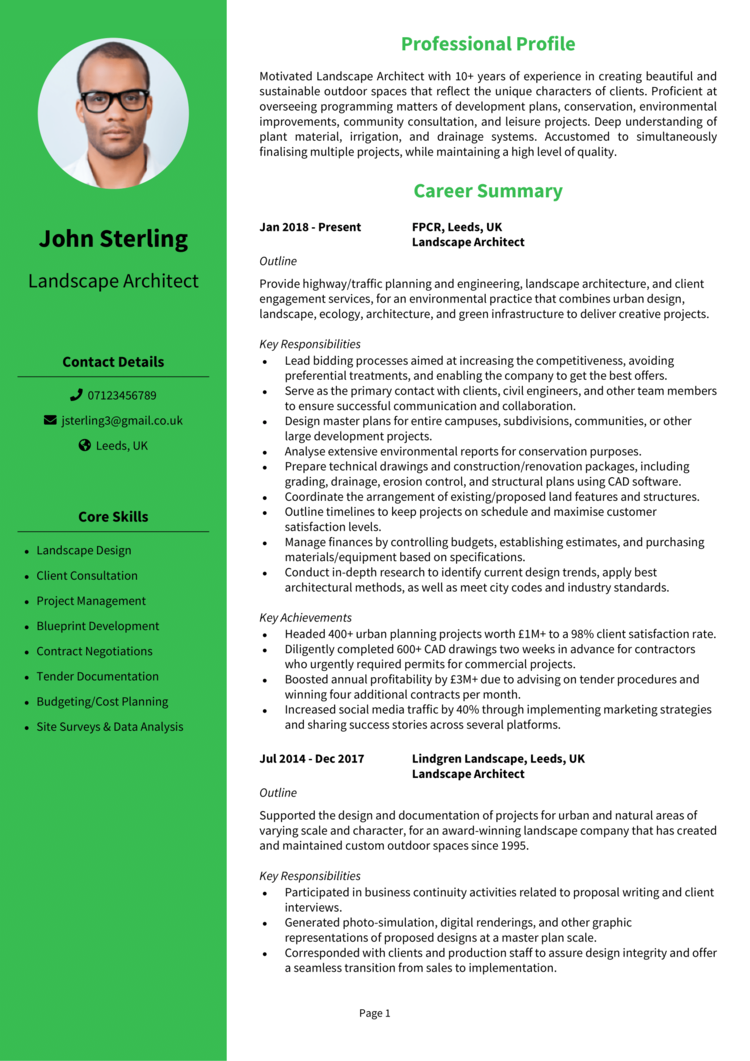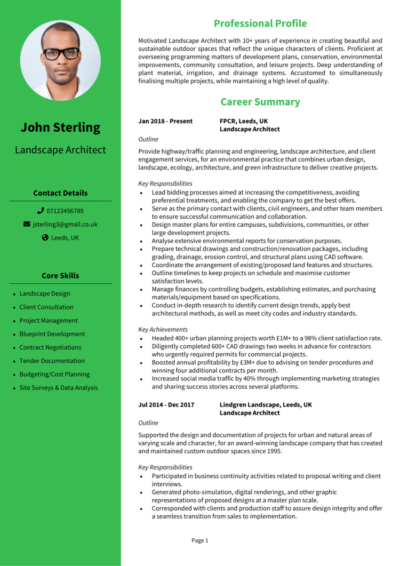It’s time to shape your next professional landscape. A well-crafted CV can be the blueprint for your next big opportunity, whether you’re eyeing up a design firm or local authority.
This guide and its Landscape Architect CV example will walk you through what to include, how to present it, and how to reflect the full scope of your creative and technical ability – without burying it under piles of planning jargon.
Landscape Architect CV

How to write your Landscape Architect CV
Discover how to craft a winning Landscape Architect CV that lands interviews with this simple step-by-step guide.
Landscape architecture lives in the overlap between art, science, and place-making. You’re shaping how people live and move, and connect with the environment. Writing a CV should echo that clarity and intention. From technical fluency to environmental awareness, this guide will help you express your full range of skills in a format that feels as carefully considered as the spaces you design.
Landscape Architect CV format and structure guidelines


Whether you’re presenting to clients or submitting planning proposals, structure matters – and your CV should reflect the same level of attention to layout and flow. A well-organised CV shows that you can communicate clearly, which is just as important as your design skills.
Here’s the layout to follow:
- Name and contact details – Display your personal details clearly at the top so employers can get in touch easily. Including a photo is entirely optional.
- Profile – Begin with a concise summary that highlights your expertise and what you bring to the role.
- Core skills – Highlight your strongest skills that align with the role’s requirements.
- Work experience – Start with your most recent role and work backwards, showcasing achievements and responsibilities.
- Education – Mention your degrees, certifications, and any training that supports your career path.
- Additional info – Include any additional details, like awards, professional memberships, or hobbies that highlight your skills or personality.
Use bullet points to break up dense blocks of text – any recruiter will appreciate it. Choose a professional, easy-to-read font, and don’t let your design instincts lead you into overly decorative formatting – let your portfolio do the creative heavy lifting. Keep your CV length to two pages to avoid overwhelming or boring recruiters. A good format which follows the above tips shows you’ve got the qualities hiring managers are looking for.
Creating a strong Landscape Architect profile


Think of this paragraph as your personal design brief: a concise overview that sets the tone for the rest of your CV. It should reflect your identity as a designer and collaborator – showing recruiters why you’re the right person to shape their next project.
Focus on your ability to balance environmental responsibility with creative vision, and your understanding of how landscape architecture supports communities and placemaking. Your CV profile is your first opportunity to prove the value you offer.
Landscape Architect CV profile examples
Profile 1
Experienced Landscape Architect with over 10 years of experience designing and managing public realm, commercial, and ecological restoration projects. Skilled in producing masterplans, planting schemes, and detailed technical drawings using AutoCAD and Revit. Passionate about sustainable design and placemaking that enhances community well-being.
Profile 2
Creative Landscape Architect with seven years working on urban parks, residential developments, and green infrastructure for both public and private sector clients. Proficient in GIS mapping, environmental assessments, and 3D visualisations. Strong collaborator with a track record of delivering multifunctional outdoor spaces on time and to budget.
Profile 3
Detail-focused Landscape Architect with five years of experience across conceptual and technical phases of landscape design. Experienced in producing planning documents, tender packages, and landscape character assessments. Proficient in Lumion, SketchUp, and Adobe Creative Suite with a strong eye for aesthetic and ecological balance.
Details to put in your Landscape Architect CV profile
Include the following:
- Where you worked – Outline the firms, government agencies, or consultancies you’ve worked with, noting the kinds of projects you’ve contributed to.
- Your top qualifications – Include your degree and any professional accreditations or chartered status.
- Essential skills – Mention your design process, planning knowledge, and ability to collaborate with multidisciplinary teams.
- Project types – Briefly refer to the kinds of environments you’ve helped shape – urban parks, green infrastructure, public spaces, etc.
- Value delivered – Show how your work improved accessibility, biodiversity, community use, or long-term maintenance.
Show off the core skills recruiters look for


This section gives hiring managers a quick overview of what you bring to a project – from your planning expertise to your fluency with design workflows. It’s especially helpful when you’re applying for roles in competitive firms or government projects with strict requirements.
Make sure the CV skills you highlight match the job specification, and avoid being too generic. This section should reflect tangible, practical competencies – not just a love of green space. Keep it all aligned to the specific role you’re targeting.
Most important skills for a Landscape Architect
- Site Analysis and Environmental Assessment – Evaluating land conditions, climate, and existing ecosystems to inform sustainable design decisions.
- Conceptual and Master Planning – Developing large-scale landscape plans and design concepts for parks, urban spaces, campuses, or residential areas.
- Planting Design and Horticultural Knowledge – Selecting appropriate plant species based on soil, climate, and aesthetic goals for long-term landscape health.
- 3D Modelling and CAD Software Use – Creating detailed plans and visualisations using software such as AutoCAD, SketchUp, Rhino, or Lumion.
- Sustainable and Ecological Design – Integrating green infrastructure, stormwater management, and biodiversity-friendly practices into landscape projects.
- Construction Documentation and Detailing – Producing technical drawings, specifications, and documentation for contractors and regulatory approval.
- Project Management and Coordination – Overseeing timelines, budgets, and coordination with engineers, planners, and contractors during project delivery.
- Community Engagement and Stakeholder Consultation – Leading public consultations and integrating feedback into landscape proposals.
- Regulatory Compliance and Planning Policy – Ensuring landscape designs meet local planning regulations, zoning codes, and environmental guidelines.
- Site Supervision and Quality Control – Visiting construction sites to ensure projects are built to specification and resolving on-site challenges.
Describing your work experience


As a landscape architect, your work experience section should reflect both your design contributions and your real-world results. It’s not just about what you created – it’s how you collaborated and delivered value.
List your jobs in reverse chronological order, starting with your most recent. Begin each role with a short summary of the company or project scope, then use bullet points to showcase your responsibilities and key results. Be specific about the scale, complexity, and outcomes of each project – especially where you played a central role in planning or delivery.
What’s the correct way to structure job history on your CV?

- Outline – Provide an overview of your role and the organisation you worked for. Mention project types, client sectors, or planning stages you were involved in.
- Responsibilities – Use action words like “designed” and “coordinated.” For example: “designed soft landscaping elements for a city centre regeneration project” or “coordinated planning submissions with the local authority.”
- Achievements – Show how your designs were implemented or approved. Highlight successful bids, sustainability benchmarks, or improvements in community use or environmental impact.
Sample work experience for Landscape Architects
Landscape Architect | Strathley Design Studio
Outline
Managed landscape design and planning for large-scale residential developments and mixed-use spaces for a national architecture firm.
Responsibilities
- Produced site masterplans, detailed planting schedules, and construction drawings
- Conducted site appraisals and collaborated with ecologists and engineers
- Prepared planning submissions and supported public consultation events
- Managed project budgets, timelines, and communication with clients
- Provided landscape input at design team meetings and technical reviews
Achievements
- Delivered three major residential landscape schemes in London and the South East
- Helped secure planning approval for a 250-unit development through design-led presentation
- Reduced project delays by streamlining drawing package workflows
Landscape Architect | Veridian Environmental Planning
Outline
Delivered landscape and visual impact assessments and design solutions for infrastructure and conservation projects across the UK.
Responsibilities
- Conducted LVIA reports for road schemes, wind farms, and flood alleviation projects
- Prepared photomontages and zone of theoretical visibility (ZTV) mapping
- Developed mitigation strategies to integrate schemes into sensitive landscapes
- Worked closely with planning consultants, ecologists, and surveyors
- Contributed to stakeholder engagement and community consultation materials
Achievements
- Supported successful planning for a 50MW solar farm with minimal visual objections
- Created template-based LVIA documents that improved team efficiency
- Developed guidance adopted internally for landscape mitigation on rural infrastructure
Landscape Architect | Noven Urban Environments
Outline
Provided design support for streetscapes, roof gardens, and urban greening initiatives for a studio specialising in city-centre regeneration.
Responsibilities
- Developed concept plans and 3D visuals for public realm schemes
- Specified planting palettes suited to microclimates and urban environments
- Assisted in producing tender documents and working drawings
- Attended site inspections and coordinated with contractors during installation
- Contributed to sustainability assessments and BREEAM reporting
Achievements
- Co-designed award-winning pocket park recognised in regional design awards
- Delivered a rooftop terrace project within four months from concept to completion
- Reduced costs on urban greening scheme through alternative material sourcing
What should your CV’s education section include?


Your education section underpins your technical and theoretical foundation. List your most relevant degrees and training – particularly if accredited by the Landscape Institute or equivalent. If your studies involved planning law, environmental science, or sustainability, it’s worth making that clear.
There’s no need to include a long list of modules, but your degrees, honours, and relevant training courses should be named and dated clearly. You can also mention licensure pathways, CPD, or postgraduate certifications – particularly if they relate to urban design or environmental management.
What qualifications do employers look for in a Landscape Architect?
- BA/BSc or MA/MSc in Landscape Architecture – Industry-standard academic background for professional practice
- Chartered Member of the Landscape Institute (CMLI) – Demonstrates recognised professional status in the UK
- Postgraduate Diploma in Urban Design or Environmental Planning – Adds a strategic layer to your design skills
- AutoCAD, Revit, or GIS certification – Useful for showing technical fluency with industry-standard tools
- Short CPD courses in sustainability, planting design, or green infrastructure – Demonstrates continued development in key focus areas





